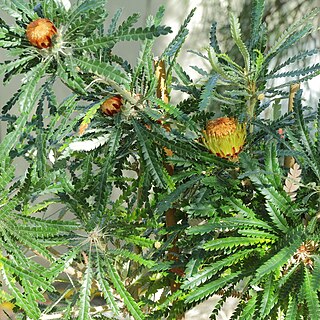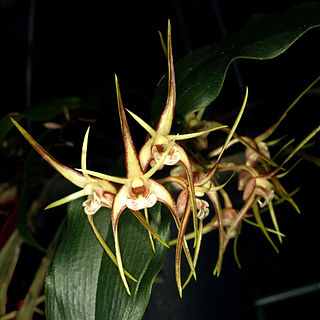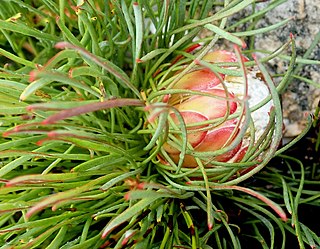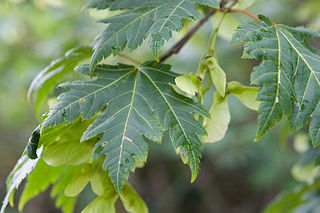
Trillium is a genus of about fifty flowering plant species in the family Melanthiaceae. Trillium species are native to temperate regions of North America and Asia, with the greatest diversity of species found in the southern Appalachian Mountains in the southeastern United States.

Trillium erectum, the red trillium, also known as wake robin, purple trillium, bethroot, or stinking Benjamin., is a species of flowering plant in the family Melanthiaceae. The plant takes its common name "wake robin" by analogy with the European robin, which has a red breast heralding spring. Likewise Trillium erectum is a spring ephemeral whose life-cycle is synchronized with that of the forests in which it lives. It is native to the eastern United States and eastern Canada from northern Georgia to Quebec and New Brunswick.

Hornbeams are hardwood trees in the flowering plant genus Carpinus in the birch family Betulaceae. The 30–40 species occur across much of the temperate regions of the Northern Hemisphere.

Acer campestre, known as the field maple, is a flowering plant species in the family Sapindaceae. It is native to much of continental Europe, Britain, southwest Asia from Turkey to the Caucasus, and north Africa in the Atlas Mountains. It has been widely planted, and is introduced outside its native range in Europe and areas of USA and Western Australia with suitable climate.

Acer micranthum, the small-leaved maple, is a species of flowering plant in the family Sapindaceae in the snakebark maple group, native to Japan, on Honshū, Kyūshū and Shikoku. Its Japanese name is the Komine maple.

Carl Johann Maximovich was a Russian botanist. Maximovich spent most of his life studying the flora of the countries he had visited in the Far East, and naming many new species. He worked at the Saint Petersburg Botanical Gardens from 1852 as curator of the herbarium collection, becoming Director in 1869.

Acer ginnala, the Amur maple, is a plant species with woody stems native to northeastern Asia from easternmost Mongolia east to Korea and Japan, and north to the Russian Far East in the Amur River valley. It is a small maple with deciduous leaves that is sometimes grown as a garden subject or boulevard tree.

Aldrovanda is a genus of carnivorous plants encompassing one extant species and numerous extinct taxa. The genus is named in honor of the Italian naturalist Ulisse Aldrovandi, the founder of the Botanical Garden of Bologna, Orto Botanico dell'Università di Bologna. Aldrovanda vesiculosa has been reported from scattered locations in Europe, Asia, Africa, and Australia.

Banksia formosa, commonly known as showy dryandra, is a species of shrub that is endemic to the south-west of Western Australia. It has pinnatipartite leaves with up to forty triangular lobes on each side, up to more than two hundred, conspicuous golden orange flowers and up to sixteen egg-shaped follicles in each head.

Rhynchospora alba, the white beak-sedge, is a plant in the sedge family, Cyperaceae. It is a tufted herbaceous perennial around 50 cm tall, with white inflorescences that flower in August. The fruit of the sedge is a small achene with a characteristic beak-like cap. It is dispersed by wind or falls by gravity, leading to individuals existing in tight clumps. The species favours wet, acidic and nutrient poor soils, thriving in Sphagnum-dominated bogs, but also peaty grasslands. As such it is often used as a positive indicator for bog and mire ecosystem health.

Dendrobium tetragonum, commonly known as the tree spider orchid, is a variable species of epiphytic or lithophytic orchid endemic to eastern Australia. Tree spider orchids are unusual in having pendulous pseudobulbs that are thin and wiry near the base then expand into a fleshy, four-sided upper section before tapering at the tip. There are only a few thin but leathery leaves at the end of the pseudobulbs and up to five flowers on relatively short flowering stems. To allow for the variations in the species there are five subspecies and a variety, some with a unique common name.

Acer palmatum, commonly known as Japanese maple, palmate maple, or smooth Japanese maple, is a species of woody plant native to Japan, Korea, China, eastern Mongolia, and southeast Russia. Many different cultivars of this maple have been selected and they are grown worldwide for their large variety of attractive forms, leaf shapes, and spectacular colors.

Persoonia rigida, commonly known as the rigid-, hairy- or stiff geebung, is a species of flowering plant in the family Proteaceae and is endemic to south-eastern Australia. It is an erect to low-lying shrub with hairy young branchlets, lance-shaped to spatula-shaped leaves that are hairy when young, and yellow flowers borne in groups of up to twenty on a rachis up to 90 mm (3.5 in) long that continues to grow after flowering.

Persoonia mollis, commonly known as soft geebung, is a plant in the family Proteaceae and is endemic to New South Wales. It is an erect to prostrate shrub with linear to oblong or spatula-shaped leaves, yellow flowers in groups of up to thirty on a rachis up to 150 mm (5.9 in) long and relatively small fruit.
The wildlife of South Korea comprises many animals, fungi and plants. Wildlife refers to animal and plant species that live in the wild or natural state such as mountains or rivers. According to the South Korean Ministry of Environment, the rich diversity of South Korea's wildlife includes 8,271 species of plants, 18,117 species of animals and 3,528 species of others. 30,000 species are known to exist in South Korea, but it is expected that there are more than 100,000 species.

Hakea longiflora is a small shrub in the family Proteaceae and is endemic to Western Australia. It has sharp, short, needle-like leaves with white flowers and a prominent red style.

Protea montana also known as the Swartberg sugarbush, is a flowering plant of the genus Protea within the family Proteaceae, which is endemic to the southwestern Cape Region of South Africa. In Afrikaans it is known as swartbergsuikerbos.

The Central Korea deciduous forests is a temperate broadleaf and mixed forests ecoregion on the Korean Peninsula, covering portions of South Korea and North Korea.

Acer sinense is a species of flowering plant in the maple genus Acer, native to southeast and south-central China. A small tree rarely reaching 15 m, it prefers to grow in forested valleys 500 to 2500 m above sea level.

Acer tschonoskii, the butterfly maple or Tschonoski's maple, is a species of shrub or small tree native to Japan and the Kuril Islands. It is one of the least invasive, easiest to grow, and hardiest species of maples, but remains rarely used in gardens. Acer tschonoskii naturally grows in subalpine habitats, at elevations between 1,400–2,500 m (4,600–8,200 ft).



















